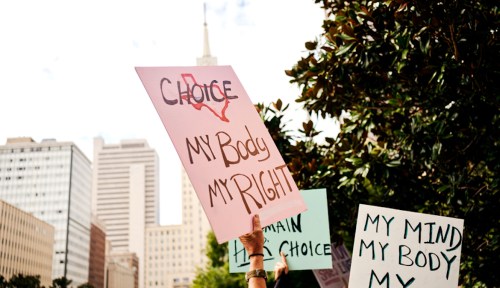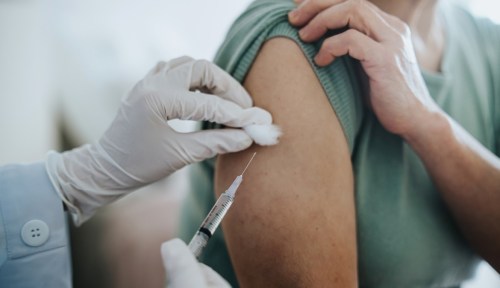In June, Roe v. Wade was overturned, effectively ending the federal right to abortion—a decision that has had far-reaching effects on abortion access in 2022 (and beyond). In a six to three majority ruling, the Supreme Court decided to leave legislation on abortion up to state governments entirely. However, many states like Texas had already encroached on reproductive rights with bans as early as six weeks gestation.
Needless to say, 2022 was a challenging year for reproductive justice and bodily autonomy in the U.S. It was also a historic year marked by protests, organizing, and renewed efforts to raise funds for local abortion networks. The fight for reproductive justice didn’t end—in fact, it’s far from over and more crucial than ever.
Here are some things that we learned about abortion and reproductive justice throughout the year.
1. Medication abortion and telehealth play a massive role in expanding reproductive care
As we collectively waited to hear the fate of the federal right to abortion in early 2022, we took a closer look at medication abortion. In the distant past, self-managed abortions were considered generally unsafe, but in 2022, having a telehealth-directed medication abortion for pregnancies up to 12 weeks gestation is quite safe and effective. Medication abortion consists of two pills: mifepristone and misoprostol. The former hormonally halts and terminates a pregnancy, while the latter initiates cramps and the expulsion of tissue.
An abortion doula and medical professionals broke down what it’s like to take these medications at home and what you might need to do to prepare.
2. Many early-term abortion bans showed signs of what was to come
Prior to the June ruling, Well+Good reported that Oklahoma joined Texas and South Carolina in their attempt to restrict abortion access in their states. Texas and South Carolina implemented six-week bans in 2021, but Oklahoma’s state legislature introduced a bill that sought to ban abortion completely. The ban foreshadowed what was to come over the summer, and unfortunately, since the overturning of Roe v. Wade, Oklahoma, is one of 13 states that has banned abortion completely.
3. An opinion draft from SCOTUS was leaked, confirming fears that abortion access was in jeopardy
In early May, a Supreme court opinion draft from Justice Clarence Thomas was leaked, which highlighted the court’s intent to make a final decision about Dobbs Vs. Jackson. The opinion confirmed fears that the federal right to abortion, and abortion access, was in jeopardy. Though the opinion was not set in stone, activists reiterated that Roe was likely going to fall, and efforts should center the most vulnerable communities and the longest-standing reproductive justice organizations, like local abortion funds.
4. Abortion rights activists discussed how this decision would impact marginalized communities
Prior to the Supreme Court’s decision, activists grew concerned about how losing the federate right to abortion would impact marginalized communities. Akilah Cadet wrote about the disproportionate impact this would have on Americans.
“The effects of this reality are undoubtedly alarming for all but would be felt to a disproportionate magnitude by historically excluded communities, like Black, Indigenous, and people of color (BIPOC); LGBTQ+; and people with disabilities,” she explained. “Bear in mind that women of color are more likely to reside in states with more restrictive-leaning abortion laws. And according to 2014 data, 75 percent of abortion patients either had an income below the federal poverty line or were designated as having a low income, making abortion cost-prohibitive. Especially if accessing an abortion—even a medically necessary one—requires traveling across state lines, a person must first find transportation, which costs time and money.”
5. On June 24, 2022, Roe v. Wade was officially overturned
As soon as Roe fell, decisions around abortion access immediately went to each individual state. In total, 26 states had laws on the books that either banned or restricted abortion access, according to the Guttmacher Institute. As of the end of 2022, thirteen states have complete abortion bans in effect.
6. People got vocal about why the right to abortion is so important to them
Protesting erupted across the country in response to this violation of bodily autonomy. Though people with uteruses are most directly impacted by this legislation, Well+Good spoke with a diverse group of people who shared their thoughts, all of whom felt that this level of restriction and government involvement in private medical decisions is unfair to any U.S. citizen.
7. It became clear that anti-abortion legislators would not stop at abortion
Well+Good broke down exactly what legislators have been saying about contraception, which also seems to be in danger. “This domino effect is not baseless conjecture: In Supreme Court Justice Clarence Thomas’s concurring opinion, he explicitly called for the Court to “reconsider all…substantive due process precedents, including Griswold, Lawrence, and Obergefell.” Griswold v. Connecticut protects the right of married couples to access contraception.”
Essentially, right-wing legislators may eventually make a case against contraception access, like the morning-after pill. However, knowing this is on the agenda is helpful for lawmakers to reaffirm the protections for contraception, and for activists to fight back.
8. Abortion was on the ballot for the 2022 midterm elections
Now that the right to abortion rested in states’ hands, the 2022 midterm election proved to be important for solidifying abortion rights in certain states. In some good news about reproductive justice in 2022, every state that had an abortion on the ballot voted in support of reproductive rights. California, Kentucky, Vermont, Michigan, and Montana (and the constituents of each of these states) voted either in support of pro-choice legislation or against anti-abortion bills.
9. Abortion access still exists, and there are so many people fighting to protect it
To round out 2022, Well + Good talked to an abortion doula about what supportive reproductive care can look like no matter what state you’re in (and the restrictions in place there). Abortion network representatives talked through how you can get connected to resources near you, and an abortion doula laid out what exactly they do to support people seeking abortions.
Yes, accessing abortion in 2022 has become very challenging for a lot of people, and the future of abortion access is murky and nerve-wracking at best. The good news is there are still so many people and organizations working tirelessly to help those in need of abortion—and fighting like hell to protect our existing rights.
Sign Up for Our Daily Newsletter
Get all the latest in wellness, trends, food, fitness, beauty, and more delivered right to your inbox.
Got it, you've been added to our email list.











